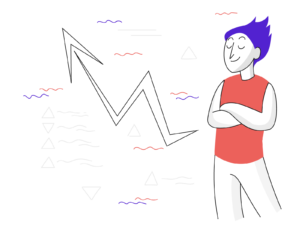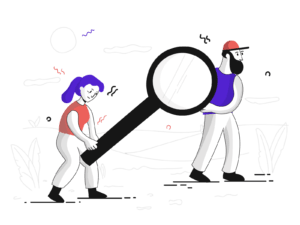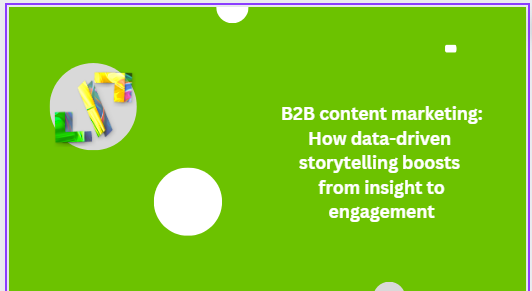When it comes to b2b content marketing, data should be driving your strategy – not the other way around. Frequenth many marketers create the content without thinking about what actually audience needs?
At the end they just create the content, and that content dosent resound with the audience and results is they are fail to achieve their desire result.
In this guide we have explore data driven content, advantages of b2b content marketing and how to use data for effective marketing. So lets dive into the article and boom your business with the help of b2b content marketing.
What is data driven storytelling?
Data driven storytelling is the method, by suing this method use the data effectively to understand the behavior of your audience and create content according to their needs.
By understanding about your audience is and what your audience seeking for, according to their requirement you can create effective content that will engage audience and encourage them to take action.
There are various ways to gather data about the audience, including surveys, customers rating and reviews, web analytics, social media listening.
Once you gather all this data, you can identify the trends and insights guides the b2b content marketing
For example, If you want to write a blog post for the benefits of the product.
So, before you start writing, look at your web analytics to know how people are searching for your site and what keywords they are using to reach your site.
You can see that most of your traffic is coming from people searching for “product review” or “product comparisons”.
This information can give good idea of type of content that is most useful to your audience, in such a case, a blog post comparing your product to others on the market.
What Is the Advantage of Data Driven Storytelling in B2B Content Marketing?
There are many advantages of data driven storytelling in B2B content marketing.
- Perhaps the most significant advantage is that it allows marketers to develop a more targeted and personalized approach to engage their audience.
- No longer do marketers have to rely on generalizations or assumptions about their target market.
- With data at their fingertips, they can develop laser-focused content that is much more likely to resonate with readers.
- As a result, this kind of b2b content marketing has the potential to drive real business results, such as higher conversion rates and increased brand awareness.
- Another key advantage of data-driven storytelling is that it can help marketers save time and resources.
- By understanding which topics and formats are most popular with their target audience, marketers can create content that is more likely to succeed without having to experiment with different ideas.
- This approach can also help avoid costly missteps, such as producing content that no one wants to read.
- In today’s competitive landscape, data driven storytelling provides B2B marketers with a major advantage.
- By understanding their audience and developing targeted content, they can engage readers like never before resulting in better business outcomes.

Data driven storytelling
Data driven storytelling is the method, by suing this method use the data effectively to understand the behavior of your audience and create content according to their needs.

B2B content marketing
the practice of producing and distributing content in order to increase brand awareness, traffic, leads and sales for business-to-business companies
How to Use Data to Create Engaging Stories
How to Use Data to Create Engaging Stories
As a content marketer, you probably already know the power of storytelling. But what you may not know is that data can be your best friend when it comes to creating engaging stories that resonate with your audience.
Here are some tips for using data to create engaging stories:
Know your audience:
The first step is to understand who your target audience is and what their needs are. Once you know this, you can start to think about the kind of story they would be interested in.
Find correct data:
Not full data is equally created. When looking for data to use in your story, make sure it comes from a reliable source and that it’s relevant to your audience.
Tell a human story:
When using data in your story, remember to focus on the human element. Data should be used to support the story, but the story should always be about people.
Make it visually appealing:
People are more likely to engage with a story if it’s visually appealing. So, when using data in your story, try to find ways to make it visually interesting (e.g., use graphs or infographics).
Examples of Data Driven Storytelling in B2B Content Marketing
In a B2B context, data driven storytelling can take many forms. For example, it can be used to create more targeted and personalized content, to identify trends and patterns in customer behaviour, or to generate new leads.
Effective data driven storytelling requires an understanding of both the data and the audience. To create compelling stories, marketers need to know what data will be most useful and interesting to their target customers.
They also need to be able to craft those stories in a way that resonates with the audience and drives them to take action.
There are many different ways to use data driven storytelling in B2B content marketing. Here are a few examples:
- Using customer data to create more targeted content: By analyzing customer data, marketers can identify trends and patterns in behavior.
- This information can be used to produce content that is more relevant and engaging for the target audience.
- For example, if you know that your customers are interested in certain topics, you can create blog posts or whitepapers on those topics.
- Or, if you see that customers are having difficulty with a particular product, you can create troubleshooting guides or FAQs.
- Generating leads with case studies: Case studies are a great way to showcase how your products or services have helped solve real-world problems for your customers.
- By featuring customer stories on your website or in your marketing materials, you can demonstrate the value of what you offer and generate new leads at the same time.
Steps for Creating a Data Story that Engages Your Audience
Data storytelling is a process of using data to create a story that engages your audience. There are three steps to creating a data story:
1) Finding the data:
The first step is to find the data that you want to use in your story. This data can come from many sources, such as surveys, customer interviews, company reports, or even social media. Once you have found the data, it is important to understand it. This means looking at the data and trying to find patterns or trends.
2) Analyzing the data:
The second step is to analyze the data. This means looking for ways to make the data more meaningful. For example, you might want to aggregate the data or create visualizations. This will help you find the most important parts of the story.
3) Creating the story:
The final step is to create the story. This means taking the data and turning it into something that your audience can understand and engage with. The best stories are those that are relatable and have a clear message.
Conclusion
Data driven storytelling is a powerful tool that can help b2b content marketing to boost their engagement rates.
By using data to create stories that resonate with their audience, marketers can connect with their readers on a deeper level and create content that is both informative and entertaining.
While data driven storytelling is an effective way to engage bb audiences, it is important to use this technique sparingly.
Overusing data driven stories can quickly turn off readers and make content seem dull and formulaic. When used judiciously, however, data driven storytelling can be a powerful tool for bb content marketers.
Reviewed By
-
algorithmchttps://blog.algorithmc.com/author/algorithmc/
-
algorithmchttps://blog.algorithmc.com/author/algorithmc/
-
algorithmchttps://blog.algorithmc.com/author/algorithmc/
-
algorithmchttps://blog.algorithmc.com/author/algorithmc/



